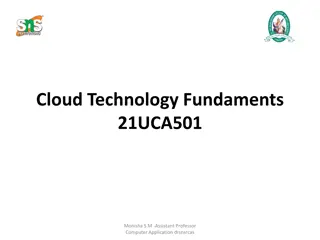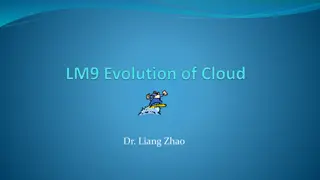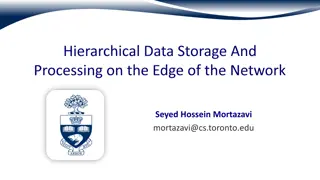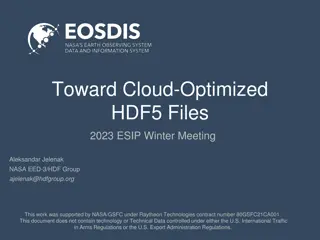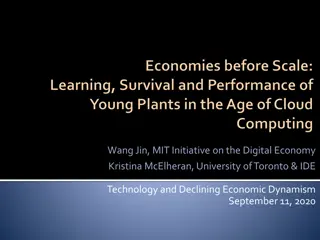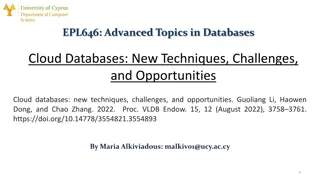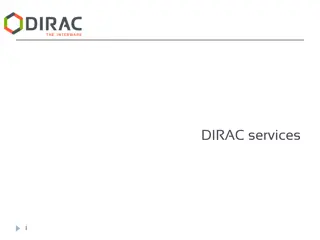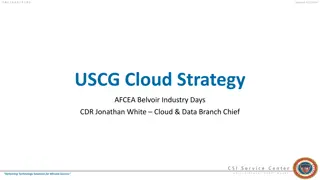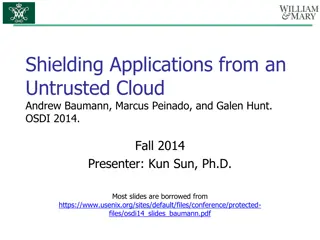Inside the Data Center: Cloud Computing Overview
Data centers play a crucial role in cloud computing, acting as hubs where traffic is filtered, directed to various tiers for processing and hosting services. Tier one handles user-facing tasks, while tier two typically consists of caching services and lightweight, scalable services. The inner tiers manage the bulk of the workload, with potentially multiple layers of caching to ease the load. Understanding the structure and functions of data centers is essential in grasping the dynamics of cloud computing services and their scalability.
Download Presentation

Please find below an Image/Link to download the presentation.
The content on the website is provided AS IS for your information and personal use only. It may not be sold, licensed, or shared on other websites without obtaining consent from the author.If you encounter any issues during the download, it is possible that the publisher has removed the file from their server.
You are allowed to download the files provided on this website for personal or commercial use, subject to the condition that they are used lawfully. All files are the property of their respective owners.
The content on the website is provided AS IS for your information and personal use only. It may not be sold, licensed, or shared on other websites without obtaining consent from the author.
E N D
Presentation Transcript
CS5412 Spring 2016 (Cloud Computing: Birman) 1 CS5412: DIVING IN: INSIDE THE DATA CENTER Lecture V Ken Birman
Weve seen one cloud service 2 Inside a cloud, Dynamo is an example of a service used to make sure that cloud-hosted applications can scale at low cost It offers a very scalable key-value way to store and fetch data, and this model is veryimportant and popular, probably the single most important idea in all of cloud computing! But it isn t the only example of a cloud service we should know about CS5412 Spring 2016 (Cloud Computing: Birman)
Data centers 3 Once traffic reaches a data center it tunnels in First passes through a filter that blocks attacks Next, a router that directs it to a tier one computer (one of many) hosting the proper services Each hosted company has its own domain but also runs inside a kind of virtual enterprise: looks like a private network, with its own IP addresses etc. These can make use of shared services provided by the cloud provider, like file system services CS5412 Spring 2016 (Cloud Computing: Birman)
Tier two and Inner Tiers 4 If tier one faces the user and constructs responses, what lives in tier two? Caching services are very common (many flavors) Other kinds of rapidly responsive lightweight services that are massively scaled Inner tier services might still have online roles, but tend to live on smaller numbers of nodes: maybe tens rather than hundreds or thousands CS5412 Spring 2016 (Cloud Computing: Birman)
Tier two and Inner Tiers 5 Tiers one and two soak up the load This reduces load on the inner tiers, and in fact there may be further layers of caching to soak up load outside the data center (Akamai, Facebook edge, etc.) Many services use asynchronous streams of updates Send updates down towards inner services but don t wait and don t hold locks! Notifications percolate up, often showing up much later. Meanwhile, tier one runs with potentially out-of-data cached data. Tier 1 Service Tier 1 Service Tier 1 ServiceTier 1 Tier 1 Service Service Backend DB CS5412 Spring 2016 (Cloud Computing: Birman)
Contrast with Back office 6 A term often used for services and systems that don t play online roles In some sense the whole cloud has an outward facing side, handling users in real-time, and an inward side, doing offline tasks Still can have immense numbers of nodes involved but the programming model has more of a batch feel to it For example, MapReduce (Hadoop) CS5412 Spring 2016 (Cloud Computing: Birman)
Some interesting services well consider 7 Memcached: In-memory caching subsystem Dynamo: Amazon s shopping cart BigTable: A sparse table for structured data GFS: Google File System Chubby: Google s locking service Zookeeper: File system with locking, strong semantics TAO: Used by Facebook to track relationships such as Friends and Likes MapReduce: Functional computing for big datasets CS5412 Spring 2016 (Cloud Computing: Birman)
Connection to DHT concept 8 Last time we focused on a P2P style of DHT These services are mostly built as layers over a data center DHT deployment Same idea and similar low-level functionality But inside the data center we can avoid costly indirect routing. We ll discuss that next time. CS5412 Spring 2016 (Cloud Computing: Birman)
Memcached 9 Very simple concept: High performance distributed in-memory caching service that manages objects Key-value API has become an accepted standard Many implementations Simplest versions: just a library that manages a list or a dictionary Fanciest versions: distributed services implemented using a cluster of machines CS5412 Spring 2016 (Cloud Computing: Birman)
Memcached API 10 Memcached defines a standard API Defines the calls the application can issue to the library or the server (either way, it looks like library) In theory, this means an application can be coded and tested using one version of memcached, then migrated to a different one function get_foo(foo_id) foo = memcached_get("foo:" . foo_id) if foo != null return foo foo = fetch_foo_from_database(foo_id) memcached_set("foo:" . foo_id, foo) return foo end CS5412 Spring 2016 (Cloud Computing: Birman)
A single memcached server is easy 11 Today s tools make it trivial to build a server Build a program Designate some of its methods as ones that expose service APIs Tools will create stubs: library procedures that automate binding to the service Now run your service at a suitable place and register it in the local registry Applications can do remote procedure calls, and these code paths are heavily optimized: quite fast CS5412 Spring 2016 (Cloud Computing: Birman)
Can one use a cluster to host a scalable version of Memcached? 12 This is what Amazon s Dynamo service does! Built over a version of Chord DHT Basic idea is to offer a key-value API, like memcached But now we ll have thousands of service instances Used for shopping cart: a very high-load application Basic innovation? To speed things up (think BASE), Dynamo sometimes puts data at the wrong place Idea is that if the right nodes can t be reached, put the data somewhere in the DHT, then allow repair mechanisms to migrate the information to the right place asynchronously CS5412 Spring 2016 (Cloud Computing: Birman)
Dynamo in practice 13 Suppose key should map to N56 Dynamo replicates data on neighboring nodes (N1 here) Will also save key,value on subsequent nodes if targets don t respond Data migrates to correct location eventually CS5412 Spring 2016 (Cloud Computing: Birman)
Dynamo in practice 14 When Amazon rolled Dynamo out, there was a huge need for scalable key-value storage, and Dynamo responded to this (e.g. shopping cart) But in fact it wasn t popular with people more familiar with database APIs Eventually Amazon introduced Dynamo-DB which has a NoSQL API: SQL but with weak consistency. This has been far more successful for many uses. CS5412 Spring 2016 (Cloud Computing: Birman)
Lessons learned? 15 Notice that we started with Chord: a DHT for big P2P uses. But nobody has big P2P systems! Dynamo was initially just Chord adapted for use inside a data-center, as a service, adjusted to deal with the peculiar failure patterns seen at Amazon. But ultimately, with Dynamo-DB, Amazon was forced to change the model to bridge to developers. CS5412 Spring 2016 (Cloud Computing: Birman)
BigTable 16 Yet another key-value store! Built by Google over their GFS file system and Chubby lock service Idea is to create a flexible kind of table that can be expanded as needed dynamically Like Dynamo-DB, starts with a DHT idea but then grew to become a specialized solution with many features CS5412 Spring 2016 (Cloud Computing: Birman)
Data model: a big map <Row, Column, Timestamp> triple for key Arbitrary columns on a row-by-row basis Column family:qualifier. Family is heavyweight, qualifier lightweight Column-oriented physical store- rows are sparse! Does not support a relational model No table-wide integrity constraints No multirow transactions CS5412 Spring 2016 (Cloud Computing: Birman) 17
API 18 Metadata operations Create/delete tables, column families, change metadata Writes (atomic) Set(): write cells in a row DeleteCells(): delete cells in a row DeleteRow(): delete all cells in a row Reads Scanner: read arbitrary cells in a bigtable Each row read is atomic Can restrict returned rows to a particular range Can ask for just data from 1 row, all rows, etc. Can ask for all columns, just certain column families, or specific columns CS5412 Spring 2016 (Cloud Computing: Birman)
Versions 19 Data has associated version numbers To perform a transaction, create a set of pages all using some new version number Then can atomically install them For reads can let BigTable select the version or can tell it which one to access CS5412 Spring 2016 (Cloud Computing: Birman)
How did they build it 20 We ll skim very lightly over the main data structures but you don t need to learn the details Idea is just to have a feeling for how it works And how does it work? They map BigTable down to a kind of key-value system! CS5412 Spring 2016 (Cloud Computing: Birman)
SSTable Immutable, sorted file of key-value pairs Chunks of data plus an index Index is of block ranges, not values SSTable 64K block 64K block 64K block Index CS5412 Spring 2016 (Cloud Computing: Birman) 21
Tablet Contains some range of rows of the table Built out of multiple SSTables Start:aardvark End:apple Tablet SSTable SSTable 64K block 64K block 64K block 64K block 64K block 64K block Index Index CS5412 Spring 2016 (Cloud Computing: Birman) 22
Table Multiple tablets make up the table SSTables can be shared Tablets do not overlap, SSTables can overlap Tablet Tablet apple boat aardvark apple_two_E SSTable SSTable SSTable SSTable CS5412 Spring 2016 (Cloud Computing: Birman) 23
Finding a tablet Stores: Key: table id + end row, Data: location Cached at clients, which may detect data to be incorrect in which case, lookup on hierarchy performed Also prefetched (for range queries) CS5412 Spring 2016 (Cloud Computing: Birman) 24
Finding a tablet 25 Stepping back, can you see how this is a bit like using a DHT in two layers? To look for something, you use the row and column information as a key, and that key lets you find the metadata on the tablet server, and then you can track down the actual data So the DHT (key-value) concept can be turned into this very fancy infinitely large table! CS5412 Spring 2016 (Cloud Computing: Birman)
Programming model 26 Application reads information Uses it to create a group of updates Then uses group commit to install them atomically Conflicts? One wins and the other fails , or perhaps both attempts fail But this ensures that data moves in a predictable manner version by version: a form of the ACID model! Thus BigTable offers strong consistency, up to a limit There are failure cases they deliberately don t cover CS5412 Spring 2016 (Cloud Computing: Birman)
Microbenchmarks CS5412 Spring 2016 (Cloud Computing: Birman) 27
Performance CS5412 Spring 2016 (Cloud Computing: Birman) 28
Application at Google CS5412 Spring 2016 (Cloud Computing: Birman) 29
So where does this table live? 30 Google actually stores the table inside its global file system or GFS GFS is a kind of DHT too! It has a name node service where you can find a list of data nodes and a key-value mapping from file name to data nodes that host that file (actually, chunks of that file, because Google s files are huge) Sort of the same idea as we just saw for BigTable CS5412 Spring 2016 (Cloud Computing: Birman)
GFS and Chubby 31 GFS file system used under the surface for storage Has a master and a set of chunk servers To access a file, ask master it directs you to some chunk server and provides a capability That server sends you the data Chubby lock server Implements locks with varying levels of durability Implemented over Paxos, a protocol we ll look at a few lectures from now CS5412 Spring 2016 (Cloud Computing: Birman)
GFS Architecture 32 CS5412 Spring 2016 (Cloud Computing: Birman)
Write Algorithm is trickier 33 1. Application originates write request. 2. GFS client translates request from (filename, data) -> (filename, chunk index), and sends it to master. 3. Master responds with chunk handle and (primary + secondary) replica locations. 4. Client pushes write data to all locations. Data is stored in chunkservers internal buffers. 5. Client sends write command to primary. CS5412 Spring 2016 (Cloud Computing: Birman)
Write Algorithm is trickier 34 6. Primary determines serial order for data instances stored in its buffer and writes the instances in that order to the chunk. 7. Primary sends serial order to the secondaries and tells them to perform the write. 8. Secondaries respond to the primary. 9. Primary responds back to client. Note: If write fails at one of chunkservers, client is informed and retries the write. CS5412 Spring 2016 (Cloud Computing: Birman)
Write Algorithm is trickier 35 CS5412 Spring 2016 (Cloud Computing: Birman)
Write Algorithm is trickier 36 CS5412 Spring 2016 (Cloud Computing: Birman)
Weve only scratched the surface 37 We ve focused on scalable storage But there are many other major, important services What are some examples? We don t have time for deep dives but can at least mention a few CS5412 Spring 2016 (Cloud Computing: Birman)
Zookeeper 38 Created at Yahoo! Integrates locking and storage into a file system Files play the role of locks Also has a way to create unique version or sequence numbers But basic API is just like a Linux file system Implemented using virtual synchrony protocols (we ll study those too, when we talk about Paxos) Extremely popular, widely used CS5412 Spring 2016 (Cloud Computing: Birman)
TAO 39 At Facebook the need is sort of different from Google or Yahoo Facebook is concerned mostly with the relationships between people and companies or other things A likes B (and B likes A), A friends B (and B friends A), A tracks updates by B (and B sends updates to A) This involves a whole collection of graphs TAO is a fancy file system like GFS or Zookeeper but specialized to track these kinds of graphs CS5412 Spring 2016 (Cloud Computing: Birman)
TAO 40 Some TAO ideas One is to try and use key-value caching at the edge to be super fast even at risk of using stale data for a little while Updates flow in a huge pipeline towards the core of the cloud, are done in a batched way, then cache- updates flow back out. Every layer has redundancy and backup options if the layer below it is broken temporarily We ll study TAO more carefully later CS5412 Spring 2016 (Cloud Computing: Birman)
What about MapReduce (Hadoop) 41 So famous that people have heard of it as often as TCP/IP or XML This is an example of a service that lives deeper in the cloud and isn t used while processing requests from clients Instead, MapReduce is useful for offline tasks CS5412 Spring 2016 (Cloud Computing: Birman)
MapReduce 42 Used for functional style of computing with massive numbers of machines and huge data sets Works in a series of stages Maptakes some operations and maps it on a set of servers so that each does some part The operations are functional: they don t modify the data they read and can be reissued if needed Result: a large number of partial results, each from running the function on some part of the data Reduce combines these partial results to obtain a smaller set of result files (perhaps just one, perhaps a few) Often iterates with further map/reduce stages CS5412 Spring 2016 (Cloud Computing: Birman)
Hadoop 43 Open source MapReduce Has many refinements and improvements Widely popular and used even at Google! Challenges Dealing with variable sets of worker nodes Computation is functional; hard to accommodate adaptive events such as changing parameter values based on rate of convergence of a computation CS5412 Spring 2016 (Cloud Computing: Birman)
Classic MapReduce examples 44 Make a list of terms appearing in some set of web pages, counting the frequency Find common misspellings for a word Sort a very large data set via a partitioning merge sort Nice features: Relatively easy to program Automates parallelism, failure handling, data management tasks CS5412 Spring 2016 (Cloud Computing: Birman)
MapReduce debate 45 The database community dislikes MapReduce Databases can do the same things In fact can do far more things And database queries can be compiled automatically into MapReduce patterns; this is done in big parallel database products all the time! Counter-argument: Easy to customize MapReduce for a new application Hadoop is free, parallel databases not so much CS5412 Spring 2016 (Cloud Computing: Birman)
Summary 46 We ve touched upon a series of examples of cloud computing infrastructure components Each really could have had a whole lecture They aren t simple systems and many were very hard to implement! Hard to design hard to build hard to optimize for stable and high quality operation at scale Major teams and huge resource investments Design decisions that may sound simple often required very careful thought and much debate and experimentation! CS5412 Spring 2016 (Cloud Computing: Birman)
Summary 47 Some recurring themes Data replication using (key,value) tuples Anticipated update rates, sizes, scalability drive design Use of multicast mechanisms: Paxos, virtual synchrony Need to plan adaptive behaviors if nodes come and go, or crash, while system is running High value for latency tolerant solutions Extremely asynchronous structures Parallel: work gets done out there Many offer strong consistency guarantees, but not necessarily for every aspect. Selective guarantees. CS5412 Spring 2016 (Cloud Computing: Birman)


